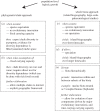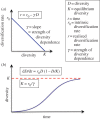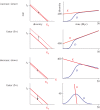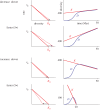The uncertain role of diversity dependence in species diversification and the need to incorporate time-varying carrying capacities
- PMID: 26977059
- PMCID: PMC4810812
- DOI: 10.1098/rstb.2015.0217
The uncertain role of diversity dependence in species diversification and the need to incorporate time-varying carrying capacities
Abstract
There is no agreement among palaeobiologists or biologists as to whether, or to what extent, there are limits on diversification and species numbers. Here, we posit that part of the disagreement stems from: (i) the lack of explicit criteria for defining the relevant species pools, which may be defined phylogenetically, ecologically or geographically; (ii) assumptions that must be made when extrapolating from population-level logistic growth to macro-evolutionary diversification; and (iii) too much emphasis being placed on fixed carrying capacities, rather than taking into account the opportunities for increased species richness on evolutionary timescales, for example, owing to increased biologically available energy, increased habitat complexity and the ability of many clades to better extract resources from the environment, or to broaden their resource base. Thus, we argue that a more effective way of assessing the evidence for and against the ideas of bound versus unbound diversification is through appropriate definition of the relevant species pools, and through explicit modelling of diversity-dependent diversification with time-varying carrying capacities. Here, we show that time-varying carrying capacities, either increases or decreases, can be accommodated through changing intrinsic diversification rates (diversity-independent effects), or changing the effects of crowding (diversity-dependent effects).
Keywords: ecological saturation; evolutionary innovation; extinction; logistic growth; speciation; species equilibrium.
© 2016 The Author(s).
Figures





References
-
- MacArthur RH, Wilson EO. 1967. The theory of island biogeography. Princeton, NJ: Princeton University Press.
-
- Sepkoski JJ. 1978. A kinetic model of Phanerozoic taxonomic diversity. I. Analysis of marine orders. Paleobiology 4, 223–251.
-
- Sepkoski JJJ. 1979. A kinetic model of Phanerozoic taxonomic diversity. II. Early Phanerozoic families and multiple equilibria. Paleobiology 5, 222–251. (10.2307/2400257) - DOI
-
- Sepkoski JJJ. 1984. A kinetic model of Phanerozoic taxonomic diversity. III. Post-Paleozoic families and mass extinctions. Paleobiology 10, 246–267.
-
- Walker TD, Valentine JW. 1984. Equilibrium models of evolutionary species diversity and the number of empty niches. Am. Nat. 124, 887–889. (10.1086/284322) - DOI
Publication types
MeSH terms
LinkOut - more resources
Full Text Sources
Other Literature Sources

